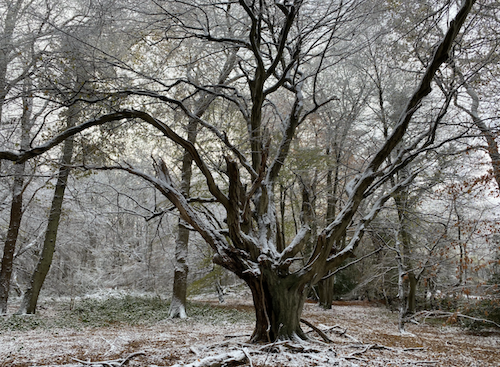Markstakes Common is an ancient wood in East Sussex. Over the last 30 months, I have made over 200 trips to learn about veteran trees, discover hundreds of fungi, and get to know this exceptional site of diverse, exceptional habitats. I hope to be around to repeat a survey of the same trees each decade to monitor their health and the health of an ancient wood that warrants designation as a site of particular scientific interest.

Veteran Oak (tree 13 in Markstakes Common) Featured on the Woodland Trust's Ancient Tree Inventory
Thirty-four veteran trees were identified in the November/December 2010 to January/February 2011 tree survey and verified by the Woodland Trust. Jonathan’s research has resulted in a further twenty-seven trees being verified as veteran trees - with an additional twenty-six being verified as ‘notable’. These are on the Woodland Trust Ancient Tree Inventory. No trees are thought to be ‘ancient’. The definitions notable, veteran and ancient relate to a combination of factors dependent on the maturity phase of a particular species of tree. Yew and oak, for example, reach their final phase of life centuries after Beech and hornbeam, while ash, and certainly birch and hawthorn, can pass through to late maturity in a hundred to 150 years.
Veteran pollard Hornbeam (a Tree of National Scientific Interest) Featured on the Woodland Trust's Ancient Tree Inventory.
It is the ‘ancient characteristics’ of hollowing trunks and branches, cavities, dead wood in the canopy and on the ground, lichen, moss, ivy, fungi, epiphytes and evidence of invertebrate activity which define the tree as ‘veteran’.
The notable tree is often a mature, healthy tree that could be older than the veteran but shows none or very few of these characteristics. Because of how and where they grow in an ancient wood, the trees compete for light by outgrowing each other into the canopy. Beech is far more shade tolerant and, therefore, ultimately dominant in the canopy than the different trees, with oak increasingly shade intolerant. Disease and damaged branches and trunks expose the tree to fungi that may cause parasitic damage.
The currently surveyed and identified collection of forever changing Markstakes Common trees now recognised as ‘veterans’ comprise seven Ash, twenty-two Beech, two Downy Birch, two Field Maple, two Holly, seventeen Hornbeam, four Oak, two Wild Apple and two Wild Cherry. Of which, nineteen are maiden, seven are old pollard, eleven are old coppice, twelve are multi-stemmed, two are dead, and seven are ‘fragmented’ (a stem or two are broken or fallen). Nine have a companion tree or trees, with these ‘companions’ being (some dead, some alive) three each of oak, hornbeam or holly.
All the veteran trees have lichen and moss, some with ivy, one or two with epiphytes, and one or two cuckoo trees, many with fungi.

A newly formed slime mould of 'False Puffball' (Enteridium lycoperdon) - white goo on the decaying trunk of a veteran hornbeam tree
Thirty-three have fungi associated with them, with Bracket fungus (Ganoderma applanatum) on five trees (with two of these trees either long since dead and another two fragmented), two with Hoof Fungus (Fomes fomentarius), several with King Alfred’s Cakes (Daldinia concentrica), two with Cinder Fungus (Kretzschmaria deusta), two with oyster mushroom (three if you include a notable tree), others with porcelain or slimy beech fungus (Oudemansiella mucida), two with Split Gill Schizophyllum commune), one with Bitter Oyster (Panelius stripticus) two with Oyster mushroom (Pleurotus ostreatus), one with veiled oyster (Pleurotus dryinus) and seventeen trees with the fungus species ‘not yet identified’, usually because whilst there is evidence of a fungus present, the fruiting body hasn’t been seen.
Thirty-four were identified in the survey from November/December 2010 to January/February 2011. Jonathan has added fifty-three trees, of which twenty-seven have been verified as veteran trees, and the remainder ‘notable’. They were added to the Woodland Trust Ancient Tree Inventory between March and September 2024.
Nine veteran trees appear on boundary banks, the most promising places for further discoveries. Two of these trees are Trees of National Special Interest: the magnificent chaliced pollarded veteran hornbeam towards the western boundary with Furzeley Farm Paddock and the long fallen but still living hornbeam on the southern boundary with Starvecrow Wood. This potential for further discoveries should keep us all intrigued and hopeful about the future of our tree survey.
The widest girths go to a Beech (tree 10) with a girth of 6.13m in 2010, a Beech (tree 2) girth of 4.86 in 2010 and now 5.09m in 2024, as well as recently added Ash coppices (5.81, and 5.33) (trees 23b & 33b)
The new additions by species are Downy Birch, Holly, Wild Apple, Purging Buckthorn and Field Maple.
There are more veterans: Ash, Field Maple, Beech, Hornbeam, Holly, and Downy Birch to add. The twenty-six notable trees of Markstakes Common on the Ancient Tree Inventory include Goat Willow, Crack Willow, Beech, Ash, Oak, and Hornbeam. Many other ‘notable’ trees will be added if a complete picture of the tree stock is required. Their presence is a valuable indication that this wood will continue to produce ‘veteran’ stock in the centuries to come.


